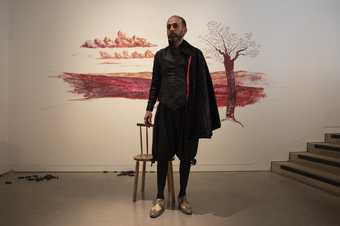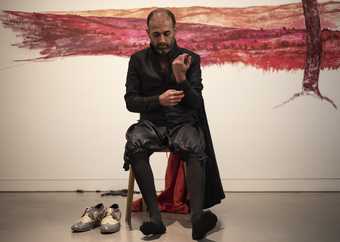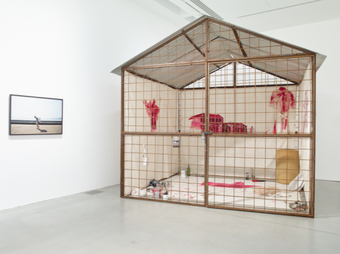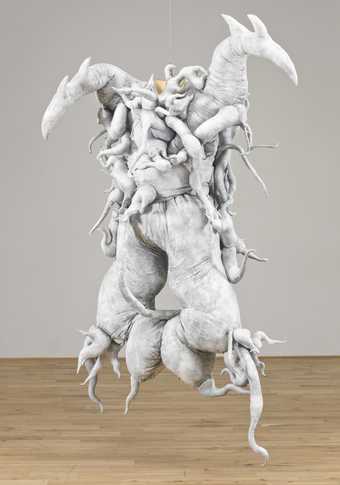
Fig.1
Nikhil Chopra performing his durational live action drawing Rouge 2019 at Kettle’s Yard, Cambridge, on 3 December 2019
Photo: Neena Percy
The conditions in which art is produced are always affected by different histories. Within this context, can transgressive playfulness rattle the cage? As a curator of Asian contemporary and live art, I am fascinated by how live performance can interrogate the workings of power, race and representation; how it can challenge embedded structures of power within institutions; and how it can reconfigure ideas of co-existence. These questions are made more pertinent in the UK by Brexit and the Home Office’s Hostile Environment policy – the system of administrative and legislative procedures designed to make it as difficult as possible for migrants to settle and live in the country.

Fig.2
Nikhil Chopra performing in La Perla Negra: Plaza di Armas 2015, installed in the exhibition Homelands: Art from Bangladesh, India and Pakistan at Kettle’s Yard, Cambridge, on 3 December 2019
Photo: Neena Percy
The exhibition Homelands: Art from Bangladesh, India and Pakistan ran at Kettle’s Yard from 12 November 2019 – 2 February 2019; it was curated by Devika Singh, Curator of International Art at Tate, and Amy Tobin, Curator of Exhibitions, Events and Research at Kettle’s Yard. It examined the complex geopolitical contexts where the implications of the events of the 1947 Partition of India and the creation of Bangladesh in 1971 continue to reverberate. The multidisciplinary works that were exhibited explored themes of home and dislocation – even as millions of people continue to be displaced across South Asia and beyond. Nikhil Chopra’s cage installation La Perla Negra: Plaza di Armas 2015 (fig.2), is featured in the gallery right next to where his performance took place. This cage is a performance remnant from when the artist embodied the persona of ‘La Perla Negra’ (a vernacular colloquial term of Black exceptionalism) for a durational drawing session of over sixty hours before being freed from the cage. Also exhibited were images of him performing as Yog Raj Chitrakar, an artistic persona based on his grandfather who was a landscape painter in Kashmir in the 1960s and 1970s. The persona has been described as ‘acknowledging its debt to the habits and habitus of princely rulers, native gentlemen, indigenous artisans, Western painters, dandies, and dreamers.’1

Fig.3
Nikhil Chopra performing his durational live action drawing Rouge 2019 at Kettle’s Yard, Cambridge, on 3 December 2019
Photos: Neena Percy
At the event, Chopra used a wall by the entrance to the exhibition galleries for his performance of Rouge, in which he drew a large mural in different shades of red lipstick over a three-hour period; at the end, the mural showed a landscape with rolling hills, clouds and a leafless tree in the foreground. Wearing heavy eyeliner, Chopra was dressed with reference to an Elizabethan bard in a corseted jacket, velvet cloak, tights, and heeled shoes, all of which evoked a theatrical playfulness. He then proceeded to mark the wall with the lipstick, rubbing the pigment in with his hands and fingers and staining them bright red. At different points throughout the three hours, Chopra performed gestures that loosely referenced the English theatre, including placing a hand on his hip and standing as if about to deliver a soliloquy. He then took up poses as if sitting for an old-fashioned portrait, making eye contact with members of the audience. Since the audience had become accustomed to patiently witnessing his process of marking, this eye contact was both disconcerting and seductive. To conclude the performance, he stripped down to a loincloth and placed his clothing on a chair with his shoes positioned neatly, as if in a still life painting.

Fig.4
Nikhil Chopra performing his durational live action drawing Rouge 2019 at Kettle’s Yard, Cambridge, on 3 December 2019
Photo: Neena Percy
After the performance, the conversation between the artist and Catherine Wood provided different entry points into understanding the performance, though was somewhat confined to art historical topics. This art historical focus constrained the scope of what they covered, denying what might have been a provocative discussion on continued post-colonial legacies in the contemporary context. Much of the initial discussion concerned landscape painting, and in particular the practice of English painters that visited India in the nineteenth century to paint its scenery. The act of making a landscape painting performed an aesthetic capturing of site, where the gaze was key to framing what was made visible and understood to be of value.
Wood further discussed how Chopra, an artist trained in painting and based in India, positioned himself in front of his landscape mural in a pose reminiscent of Gainsborough’s portraits of the British aristocracy. In Gainsborough’s works the identity and status of the sitter is mapped onto the landscape behind them, which denotes ownership, wealth and status; conversely here, the landscape takes on the codes of aspiration for the Chopra’s performance persona for whom the fantasy it is to be within it or akin to it, and yet can never be. Chopra’s theatrical assumption of such a pose exposed the ambition of that gentlemanly class to claim ownership of land, and critiques it in relation to the impact of Eurocentric legacies of power on the ‘other’ and foreign territories. Chopra then ruminated on the development of studio photography at the turn of the century, where British photographers would photograph Indian dignitaries posed in front of studio landscapes, representing the Indian ruling class while signing off land to the British Crown. Chopra recognised the irony as well as the shifting positionalities of subject and ruler that were encapsulated by the relations of the Indian elite with the British Empire.
Wood and Chopra moved onto discuss the function and form of drawing, which is a key aspect of Chopra’s performative works. At Kettle’s Yard, Chopra rendered his landscape with thick and smudged strokes of vivid red lipstick. His performance was tactile and charged – he admitted he almost bit the lipstick, and his long fingers dug into the pigments to flex their aching tiredness; his hands and fingers were stained blood red, extending the surface of his drawing from the wall onto his body and disrupting the contained flatness of the landscape into a transgressive ‘live’ space.
The sense of containment (and the idea of the uncontainable) continually seeped into the conversation. Chopra described his performance persona as ‘naughty’ in its adoption of theatrical elements considered out of place in contemporary art and in its subversion of behaviour expected of the ‘gentlemanly class’. He pointed out the levitating red handkerchief he sketched at the end of the performance and referenced the character of Iago in Shakespeare’s Othello – also seen as a cipher for the undesirable traits of envy and jealousy in a protagonist hero. Chopra also spoke of exhibiting ‘good table manners’, such as not eating too loudly, as a sign of social civility that he had been brought up with. Perhaps here, Chopra hinted that his persona’s seepage into red (the hue of passion) is itself an admittance of envy – of Empire, of power; his stripping down in the final phase of the performance perhaps represented his breaking free of the aspirations and restrictions of civilised formality. Chopra described his performance as moving away from recognisable theatrical gestures and towards reconfiguring a ‘live art’ space as an exploratory, transgressive studio space. The ‘liveness’ of this new mode, he suggested, could sculpt a process where he can throw off the armour of civility, and problematise masculinity – patriarchy exists both in British and Indian Hindu traditions – and queer his subjectivity through a dangerous intimacy with the audience. He noted, however, that while he teased the audience with coquettish, challenging stares, he nevertheless maintained the tenuous fourth wall convention in not speaking. The viewer’s returned silent gaze could thus be understood as complicit in siloing the space of the work only as ‘art’.
While the conversation unpacked in depth the themes and methods in Chopra’s practice, as a viewer I was left feeling tantalised, desiring more and wondering, for example, what might happen if the artist broke free of the constraints of contemporary art institutions? Following the conversation with Wood, Chopra confessed to wanting to shake things up even more, to create more ‘messiness’. It is difficult to imagine this occurring within the curated precision and refined environment of Kettle’s Yard. Perhaps, however, a more explosive performance and conversation would indeed question the broader cultural issues of how inherited histories and institutions perpetuate aesthetic and social codes that continue to enforce hierarchies of elitism in public life.


